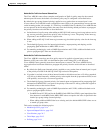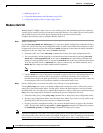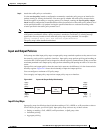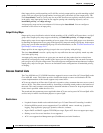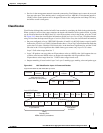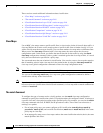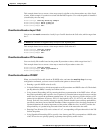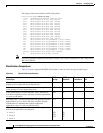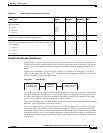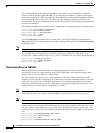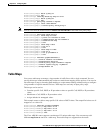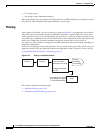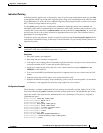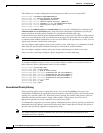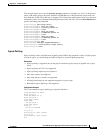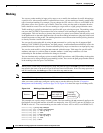
24-11
Cisco ASR 901 Series Aggregation Services Router Software Configuration Guide
OL-23826-09
Chapter 24 Configuring QoS
Understanding QoS
Classification Based on QoS Groups
A QoS group is an internal label used by the router to identify packets as a members of a specific class.
The label is not part of the packet header and is restricted to the router that sets the label. QoS groups
provide a way to tag a packet for subsequent QoS action without explicitly marking (changing) the
packet.
A QoS group is identified at ingress and used at egress; it is assigned in an input policy to identify
packets in an output policy. See Figure 24-3. The QoS groups help aggregate different classes of input
traffic for a specific action in an output policy.
Figure 24-4 QoS Groups
You can use QoS groups to aggregate multiple input streams across input classes and policy maps for the
same QoS treatment on the egress port. Assign the same QoS group number in the input policy map to
all streams that require the same egress treatment, and match to the QoS group number in the output
policy map to specify the required queuing and scheduling actions.
You can also use QoS groups to identify traffic entering a particular interface if the traffic must be treated
differently at the output based on the input interface.
You can use QoS groups to configure per-port, per-VLAN QoS output policies on the egress interface
for bridged traffic on the VLAN. Assign a QoS group number to a VLAN on the ingress interface by
configuring a per-port, per-VLAN input policy. Then use the same QoS-group number for classification
at the egress. Because the VLAN of bridged traffic does not change during forwarding through the router,
the QoS-group number assigned to the ingress VLAN can be used on the egress interface to identify the
same VLAN.
Less critical data (silver data)—noncritical, but relatively
important data.
• Level 1
• Level 2
• Level 3
AF11
AF12
AF13
10
12
14
1
1
1
1
1
1
Best-effort data (bronze data)—other traffic, including all
noninteractive traffic, regardless of importance.
Default000
Less than best-effort data—noncritical, bandwidth-intensive
data traffic given the least preference. This is the first traffic type
to be dropped.
• Level 1
• Level 2
• Level 3
2
4
6
0
0
0
0
0
0
Table 24-1 Typical Traffic Classifications (continued)
Traffic Type
DSCP
per-hop
DSCP
(decimal)
IP
Precedence CoS
1. Classify traffic
2. Set qos-group
141152
Switching
functions
1. Match qos-group
2. Output policy



